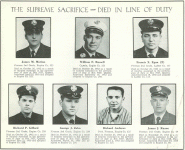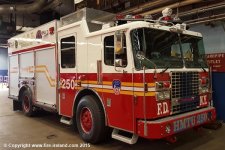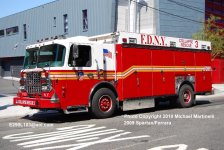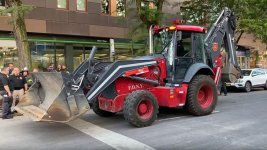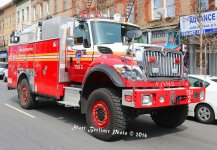Two brothers.Chief Love (The Bad Love), We Re
You are using an out of date browser. It may not display this or other websites correctly.
You should upgrade or use an alternative browser.
You should upgrade or use an alternative browser.
10-26-62...MASPETH FIRE 6 LODDs.
- Thread starter 68jk09
- Start date
- Joined
- May 6, 2010
- Messages
- 17,275
REMEMBRANCE BULLETIN....
On October 26, 1962, six members of the FDNY made the Supreme Sacrifice at Queens Box 7072. Members were checking for fire extension after an extensive exterior attack in a class 3 commercial building that housed the Sefu Fat and Soap Company. Without warning, an exterior bearing wall collapsed in a 90-degree fashion; twenty firefighters became trapped under the cinder block and metal deck of the canopies. In honor and remembrance of these members we present the following points.
• There were no overt collapse indicators at this fire. However, any building that has been exposed to intense fire for any period of time is in itself a collapse indicator. The firefighters that were killed at this fire were outside the fire building.
• The fire was declared “under control” by the Chief of Department. This declaration indicates that at this time, in the judgment of the IC, final extinguishment of the fire or control of the emergency will be accomplished by the apparatus, equipment and personnel on the scene. It does not mean that the building is safe.
• Canopies are frequently located over loading dock doors to protect employees and stock from weather. A canopy is not a safe working platform for firefighters.
• Canopies are constructed by a beam extending beyond the exterior wall. The end of the beam is supported by a tie rod that connects to a structural element of the building. When it is intact, the tie rod makes it a supported beam. If the tie rod fails, the beam protruding from the exterior wall becomes an undesigned cantilever beam. The tie rod is under tension. Any item under tension only has to fail at one point for the item to fail.
• The masonry wall that failed had many loading dock doors covered by canopies. Any wall that has many openings in it, is inherently less stable than a solid wall. When there is an eccentric load on an exterior wall, such as a canopy or a marquee, the entire wall is in danger of collapse.
• When preparing for the possibility of a 90-degree angle collapse of a masonry wall, firefighters should be withdrawn a distance of 1 1⁄2 to 2 times the height of the wall.
Issued by the Bureau of Training
On October 26, 1962, six members of the FDNY made the Supreme Sacrifice at Queens Box 7072. Members were checking for fire extension after an extensive exterior attack in a class 3 commercial building that housed the Sefu Fat and Soap Company. Without warning, an exterior bearing wall collapsed in a 90-degree fashion; twenty firefighters became trapped under the cinder block and metal deck of the canopies. In honor and remembrance of these members we present the following points.
• There were no overt collapse indicators at this fire. However, any building that has been exposed to intense fire for any period of time is in itself a collapse indicator. The firefighters that were killed at this fire were outside the fire building.
• The fire was declared “under control” by the Chief of Department. This declaration indicates that at this time, in the judgment of the IC, final extinguishment of the fire or control of the emergency will be accomplished by the apparatus, equipment and personnel on the scene. It does not mean that the building is safe.
• Canopies are frequently located over loading dock doors to protect employees and stock from weather. A canopy is not a safe working platform for firefighters.
• Canopies are constructed by a beam extending beyond the exterior wall. The end of the beam is supported by a tie rod that connects to a structural element of the building. When it is intact, the tie rod makes it a supported beam. If the tie rod fails, the beam protruding from the exterior wall becomes an undesigned cantilever beam. The tie rod is under tension. Any item under tension only has to fail at one point for the item to fail.
• The masonry wall that failed had many loading dock doors covered by canopies. Any wall that has many openings in it, is inherently less stable than a solid wall. When there is an eccentric load on an exterior wall, such as a canopy or a marquee, the entire wall is in danger of collapse.
• When preparing for the possibility of a 90-degree angle collapse of a masonry wall, firefighters should be withdrawn a distance of 1 1⁄2 to 2 times the height of the wall.
Issued by the Bureau of Training
- Joined
- Mar 3, 2007
- Messages
- 1,546
Continued Rest in Peace.
- Joined
- Jul 20, 2022
- Messages
- 437
This fire, or so I am told is a classic example of a Chief, "NOT FOLLOWING ORDERS". "The Bad Chief Love" (There we many fine good Chief Loves in the FDNY), was told by the Chief of Dept. to keep all the firemen out of the building and away from a wall and canopy, he considered very dangerous, and the Chief of Dept. left the scene. But for some reason perhaps fatigue, Chief Love failed to follow his Dept. Chiefs order and sent firemen in to overhaul the area near the damaged unsafe wall and canopy. When the collapse was over, with 6 Firemen dead, the Chief of the Department raced back to the fire, and so the story goes a fist fight went on between the 2 Chief's.
The most dangerous part of the fire can often be after the fire is under control. All the Damage already done by the fire has already happened and is at this point "AT its WORST.
FATIGUE can cause lapses in judgement, that results in great danger to firefighters. This FATIGUE can be to the firefighters, fire officers, Chief officers and "THE INDICENT COMMANDER" In short get relief for everyone for long prolonged operations, that includes the Incident Commander is needed, this results in a much safer operation. Captain Bob Rainey FDNY Engine 26 retired
The most dangerous part of the fire can often be after the fire is under control. All the Damage already done by the fire has already happened and is at this point "AT its WORST.
FATIGUE can cause lapses in judgement, that results in great danger to firefighters. This FATIGUE can be to the firefighters, fire officers, Chief officers and "THE INDICENT COMMANDER" In short get relief for everyone for long prolonged operations, that includes the Incident Commander is needed, this results in a much safer operation. Captain Bob Rainey FDNY Engine 26 retired
This Vid. from Lauren Skye is a clear-cut Example; (on a much smaller scale), of this Disaster -
a Smaller Arch/Canopy Collapse resulting in Injury, After MBFKD.
https://www.nycfire.net/forums/thre...-partial-building-collapse.79967/#post-273915
a Smaller Arch/Canopy Collapse resulting in Injury, After MBFKD.
https://www.nycfire.net/forums/thre...-partial-building-collapse.79967/#post-273915
- Joined
- Mar 30, 2023
- Messages
- 954
Mind me asking what happended to the IC? Did he face any consquences for not following the Chief of Department's Orders?This fire, or so I am told is a classic example of a Chief, "NOT FOLLOWING ORDERS". "The Bad Chief Love" (There we many fine good Chief Loves in the FDNY), was told by the Chief of Dept. to keep all the firemen out of the building and away from a wall and canopy, he considered very dangerous, and the Chief of Dept. left the scene. But for some reason perhaps fatigue, Chief Love failed to follow his Dept. Chiefs order and sent firemen in to overhaul the area near the damaged unsafe wall and canopy. When the collapse was over, with 6 Firemen dead, the Chief of the Department raced back to the fire, and so the story goes a fist fight went on between the 2 Chief's.
The most dangerous part of the fire can often be after the fire is under control. All the Damage already done by the fire has already happened and is at this point "AT its WORST.
FATIGUE can cause lapses in judgement, that results in great danger to firefighters. This FATIGUE can be to the firefighters, fire officers, Chief officers and "THE INDICENT COMMANDER" In short get relief for everyone for long prolonged operations, that includes the Incident Commander is needed, this results in a much safer operation. Captain Bob Rainey FDNY Engine 26 retired
- Joined
- Jul 20, 2022
- Messages
- 437
I believe the I.C. who was an Assistant Chief of department was forced to retire. Back then things like this were done quietly so I am not 100% positive that that is what happened, but that is what I have heard. I am sure of a few things. There was Legal actions taken by the families of the lost firemen. Department procedures were changed within a year or so, including designated Safety Chief's assigned on all multiple alarms. A Division of Safety was established not long after, as a result of this and other incidents. Now in F.D.N.Y. All Chief battalion Chief and all those ranks above "B.C." are trained as Safety Chiefs, and now any Chief can be assigned to multiple alarms, as a designated Safety Chief. FDNY now has a Signal. "10-66" Basically a Mayday! with addition resources required, and for a Collapse a signal "10-60" a Major Incident Collapse or Otherwise that requires a major response of special units. Included in both 10-66 & 10-60 a large number of Special Operations/Rescues Services Unit responses. Including up to 3 rescue Companies, Collapse Rescue Units, Squad Companies, Haz. Mat. 1, Rescue Support Ladder Companies, Tactical Support Units, Special Operations Chiefs, an additional FAST truck/s, and an additional Deputy Chief, and most recently Heavy Equpment =Front End Loaders, Collapse Pods,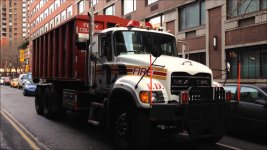
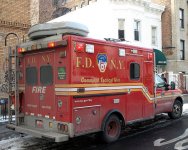

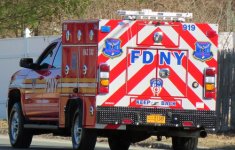
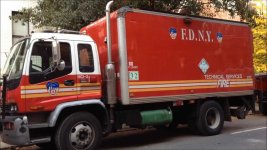
 and a Con Edison Co. Soil Vacuum unit. All this AND an additional Alarm is required to be transmitted. On FDNY can get that much expertise. and special units on major incidents. Some of these things were funded after 9/11. Here are some Online Photos of FDNY units involved in rescue responses to major incidents.
and a Con Edison Co. Soil Vacuum unit. All this AND an additional Alarm is required to be transmitted. On FDNY can get that much expertise. and special units on major incidents. Some of these things were funded after 9/11. Here are some Online Photos of FDNY units involved in rescue responses to major incidents.
Captain Bob Rainey FDNY Engine 26 retired.





 and a Con Edison Co. Soil Vacuum unit. All this AND an additional Alarm is required to be transmitted. On FDNY can get that much expertise. and special units on major incidents. Some of these things were funded after 9/11. Here are some Online Photos of FDNY units involved in rescue responses to major incidents.
and a Con Edison Co. Soil Vacuum unit. All this AND an additional Alarm is required to be transmitted. On FDNY can get that much expertise. and special units on major incidents. Some of these things were funded after 9/11. Here are some Online Photos of FDNY units involved in rescue responses to major incidents.Captain Bob Rainey FDNY Engine 26 retired.
Attachments
- Joined
- Mar 3, 2007
- Messages
- 1,546
Yes, may they continue to Rest in Peace.10-26-62 ....SIX LODD's ......CONTINUED REST IN PEACE BROTHERS
- Joined
- Jan 12, 2022
- Messages
- 85
This thread and the devastation involved speaks volumes as why reading “collapse of burning buildings” by Chief Dunn is an absolute must read by any firefighter or fire officer. May the killed continue to rest in peace.

